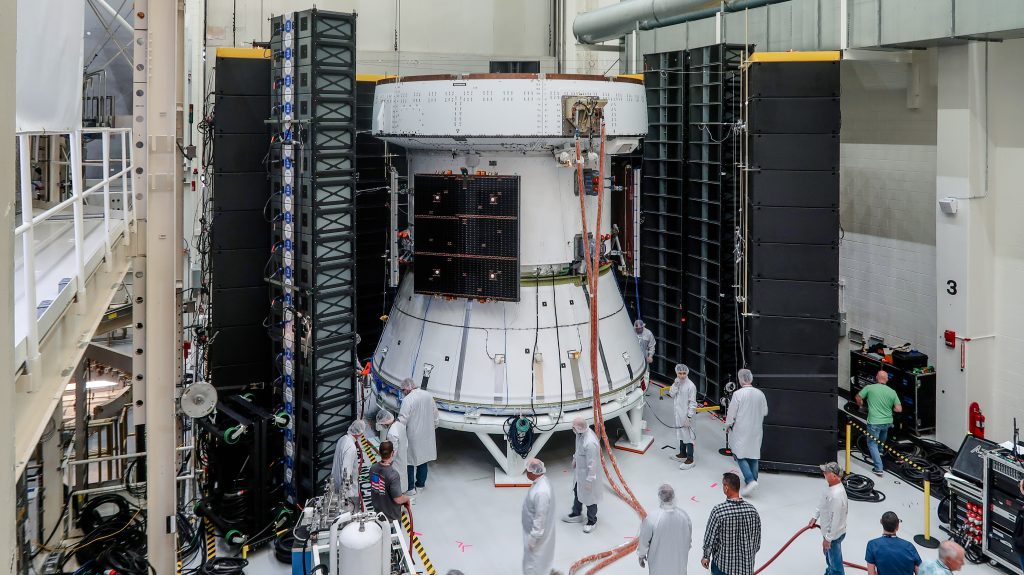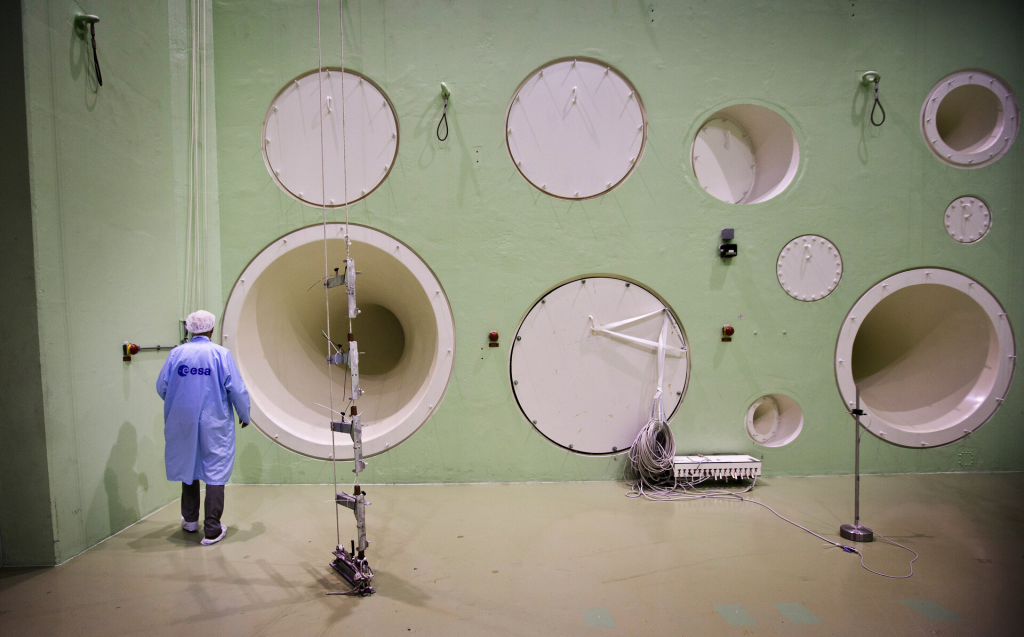Update : D-FAT testing complete!
The second European Service Module for Orion is withstanding a barrage of noise in its preparation for the Artemis II flight around the Moon. The Direct Field Acoustic Testing, or D-FAT, throws sound at spacecraft hardware to monitor its reaction. These sounds simulate the vibrations that Orion (and the four astronauts inside) will endure at liftoff for Artemis II. The astronauts themselves will be protected from the full blast of the rocket launch noise as they will be inside the spacecraft that is inside the rocket fairing – and also because they will be at the opposite end of the noisy part of the Space Launch System mega Moon rocket: The engines.
A large number of speakers are placed close to the European Service Module at strategic places and a technician turns up the wall of sound to the max. Sound pressure data and how the European Service Module copes with the battery of noise is collected with microphones, strain gauges and accelerometers. The max decibel level can reach over 140 decibels, which is louder than a jackhammer and similar to standing next to the speakers at a live rock concert.

Turn it up to the max
These tests are common for all spacecraft before launch. Most space agencies have dedicated rooms with speakers to bombard hardware with sound waves, and ESA’s Large European Acoustic Facility (LEAF) at our technical heart ESTEC in The Netherlands can crank the volume all the way up to 158.5 decibels. This is the most powerful sound system in Europe – but no human being could survive hearing it at maximum output.

For the Artemis spacecraft the tests are being done at NASA’s Operations and Checkout building at Kennedy Space Center in Florida, USA, and not in a dedicated room such as ESA’s LEAF. The lower decibels are sufficient for testing in this case as the rocket fairing surrounding the European Service Modules and Orion on launch are not installed, as these protect the Orion spacecraft from the sound, as well as the atmosphere as it rockets upwards to the Moon.

The mobile sound system used for Orion is still pretty powerful, but how powerful? ESA’s European Service Module principle mechanical engineer, Stephen Durrant, explains:
“There isn’t a straight forward answer!
It is hard to give an exact number for how much the speakers output. We (the guys running the test that is!) usually talk in terms of electrical potential:
- The subwoofers are powered by an integrated 8500 watt amplifier. With 110 subs that is nearly 1 million watts of potential power on tap just for the subs.
- The amplifiers for the mid/high speakers, add another 30000 watts per amp, for a total of another 3 million watts of potential power.
- We powered this test with a 1 MegaW generator so the system is capped by that. But a rough estimate is the test set-up was using between 40-60% of the generator capacity to power the set-up for the qual level testing. Everything in the system is horn loaded which allows for greater efficiency at higher levels.”
Good neigbours
The 140-plus-decibels that the European Service Module-2 has to endure is still very loud, so loud that it would damage your hearing without adequate protection. So loud it would have the neighbours banging at the door, and funnily enough the Orion and European Service Module teams were asked to schedule the tests to ensure that the International Space Station astronauts would be able to get a good rest before their launch.
Stephen describes the sound produced for testing: “It’s random noise (from 25Hz up to 10000Hz)… From outside the building area you hear a ‘rumble’ of the low(er) frequency noise.
“With 140dB of noise, I wouldn’t want to try to be standing next to the speakers or in the hall to try to give you a better description!!”
Astronauts who launch from Kennedy Space Center, such as Crew-6 that launched on a Falcon rocket, spend their last days and nights on Earth in the Neil Armstrong Operations and Checkout Building, the very same building where Orion is built up. Out of respect for Crew-6 the Orion teams withheld turning up the D-FAT speakers in the last nights before their launch. On 2 March Crew-6 was launched to the Space Station in Crew Dragon Endeavour spacecraft (which also had its own round of acoustic testing ) and the four astronauts are working well-rested in humankind’s largest space laboratory.
Post concert come-down
The D-FAT sound bombardment continues to check the myriad of electronics inside the European Service Module-2 are working correctly. It’s older sibling, the European Service Module-1 went through the same ordeal and passed with flying-to-the-Moon colours. When European Service Module-2 passes the test, the speakers will be packed up and the engineers will move on to the next part of producing a lunar spacecraft – installing the solar array wings.
The company that rents out the speakers for D-FATs also rents the same speakers for rock concerts. This reminds us of a cool little coincidence during the Artemis I launch: the excellent Metallica song “Orion”, released in 1986, has a running time of pretty much the same time it takes to launch the Orion spacecraft into Earth orbit. Hit play on the Spotify and Youtube links below to relive the launch with a fitting soundtrack – it really rocks!
Surely this coincidence begs to be exploited for a next Artemis launch with a live rendition by Metallica of Orion, blasting from the same speakers used to test the spacecraft (at a safe distance of course).


 Automated Transfer Vehicle page
Automated Transfer Vehicle page ATV blog archive
ATV blog archive
Discussion: 2 comments
Hi, thanks this is a very informative article but somewhat incorrect. Your statement “The company that rents out the speakers for D-FATs also rents the same speakers for rock concerts.” is not true. The MP-series loudspeakers we used to test Orion are specifically built for DFAT application and not suitable for concert: 1) they would sound not so pleasent to the ear and 2) you would need a lot of people and equipment to arrange them in a venue for music. A true statement would be “The company that rents out the speakers for D-FATs also rents speakers for rock concerts (which are designed differently from those for DFAT application).”
I would appreciate your edition of the text.
What is the difference between a speaker that is applied to a direct sound field and a concert speaker, and are there any special requirements?